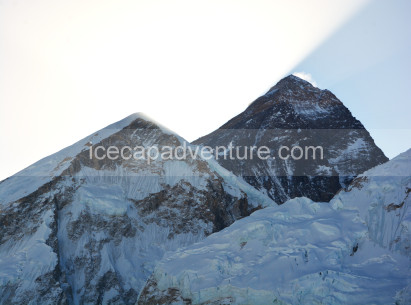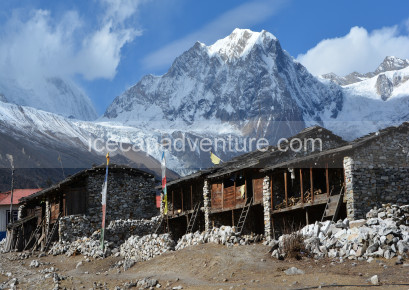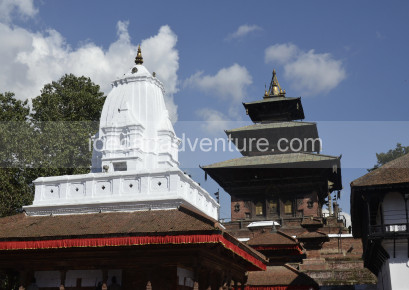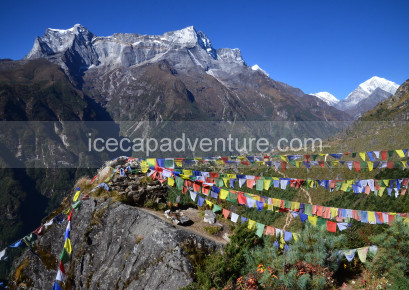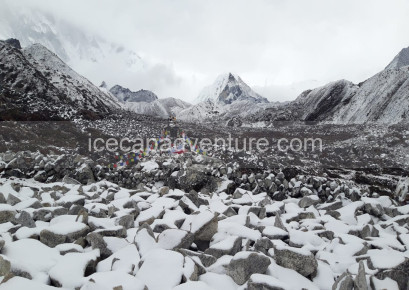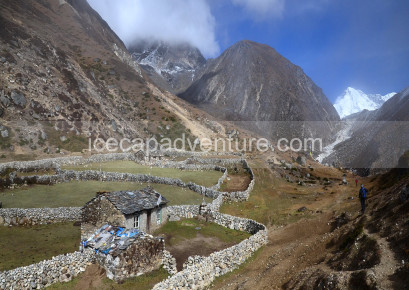.png)
.png)
.png)
.png)
.png)
.png)
.png)
-
1-4 Pax
USD $1500
-
5-9 Pax
USD $1350
-
10-20 Pax
USD $1250
-
21-30 Pax
USD $1125
Unveiling the Wonders of Everest Base Camp Trekking
Nestled within the majestic Himalayas, Everest Base Camp is a bucket-list destination for trekkers and adventure enthusiasts worldwide. Situated at an altitude of over 5,300 meters, this iconic base camp serves as the starting point for climbers embarking on the challenging journey to conquer the world’s highest peak. The trek to Everest Base Camp offers breathtaking views of snow-capped peaks, tranquil valleys, and colourful prayer flags fluttering in the wind.
The Journey to Everest Base Camp
The journey to Everest Base Camp is a once-in-a-lifetime experience that takes you through some of the most breathtaking landscapes in the world. Trekking to the base camp of the world’s highest mountain is a challenging yet rewarding adventure that will leave you with unforgettable memories.
Preparing for Your Trek
Before embarking on the trek to Everest Base Camp, it is essential to make adequate preparations to ensure a safe and enjoyable experience. This includes obtaining the necessary permits, organising transportation to the starting point of the trek, and ensuring you have the right gear and equipment.
What to Pack
When packing for your Everest Base Camp trek, it is crucial to pack light but also be prepared for changing weather conditions. Some essential items to pack include sturdy hiking boots, warm clothing layers, a good-quality sleeping bag, a first aid kit, and high-altitude medications, among others.
Physical and Mental Preparation
Trekking to Everest Base Camp requires a good level of physical fitness and mental resilience. It is recommended to start a fitness regimen well in advance of your trek, focusing on cardio exercises, strength training, and endurance-building activities. Mental preparation is also crucial, as the trek can be physically and emotionally challenging at times.
Understanding the Route
The route to Everest Base Camp takes trekkers through picturesque Sherpa villages, stunning mountain landscapes, and rugged terrain. Along the way, trekkers will pass through key stops and landmarks that offer unique cultural experiences and opportunities to interact with the local community.
Acclimatisation and Altitude Sickness
One of the most critical aspects of trekking to Everest Base Camp is acclimatisation to high altitudes. Trekkers will gradually ascend to higher elevations, taking rest days to allow their bodies to adjust to the thin air. It is essential to be aware of the symptoms of altitude sickness and to communicate any discomfort to your guide promptly. Adequate hydration, proper nutrition, and a slow pace are key to preventing altitude-related illnesses.
Overall, trekking to Everest Base Camp is a challenging yet immensely rewarding adventure that will test your physical and mental limits. By adequately preparing for the trek, understanding the route, and taking necessary precautions for acclimatisation, you can embark on this epic journey with confidence and make memories that will last a lifetime.
Accommodations and Facilities
Accommodation at Everest Base Camp is basic yet functional, with a variety of options ranging from shared tents to more comfortable lodges. Climbers and trekkers can expect communal dining areas, shared toilet facilities, and limited access to amenities such as electricity and hot showers. Despite the challenging conditions, the sense of community at EBC is strong, with climbers bonding over shared experiences, meals, and evening gatherings.
Trip Highlights:
- Kalapatthar—a wonderful viewpoint.
- Khumbu Glacier.
- Tengboche monastery.
- Everest Three Highest Passes (Kongma-La, Cho-la, and Renjo-La Pass)
- Namche Bazaar—the beautiful Sherpa capital.
- Ngozumpa glacier
1
We will be waiting to welcome you at Tribhuvan International Airport, Kathmandu, where you will be greeted with a traditional Nepali flower garland to mark your arrival. After the warm welcome, we will drive you to your hotel—approximately 30 minutes during the day and 20 minutes at night.
Upon reaching Jampa Hotel, you will be offered welcome drinks and biscuits, followed by the settlement of your rooms. Once settled, please join us back in the lobby or meeting hall for a briefing about your trekking and tour program, including an introduction to your trekking guide and other relevant details.
After the briefing, you will have the opportunity to check your trekking equipment with your guide, and we will also explain the domestic flight schedule to Lukla.
Note: If you arrive in Kathmandu at night, these activities will be scheduled for the following day after breakfast and meals.
.png)
.png)
.png)
.png)
2
After breakfast at the hotel, you will have time to explore Kathmandu’s cultural heritage sites, such as Kathmandu Durbar Square, Swayambhunath (Monkey Temple), or Boudhanath Stupa, and you will have the day to prepare for your trek.
Our team will assist you in checking your gear and ensuring you have all the necessary equipment for the journey ahead. If you need to buy or rent any trekking gear, we will guide you to the best shops in Thamel, where you can find quality items at reasonable prices.
In the evening, your trekking guide will conduct a final briefing about the trek, including route details, safety measures, and expected weather conditions. Overnight stay at a hotel in Kathmandu.
.png)
.png)
.png)
.png)
3
Your Himalayan adventure begins with an early morning flight from Kathmandu (1,350 m) to Lukla (2,860 m), one of the most scenic and thrilling mountain flights in the world. During the 40-minute flight, you’ll enjoy spectacular aerial views of the Himalayan peaks, including glimpses of Everest, Lhotse, and Nuptse, as the mountains unfold beneath you. Upon landing at the famous Lukla airstrip, you’ll meet your trekking team and begin the first steps of your trek.
The trail to Phakding (2,640 m) is mostly downhill and follows the Dudh Koshi River, crossing several suspension bridges adorned with colorful prayer flags. You’ll pass through small Sherpa settlements and pine forests, enjoying the fresh mountain air and views of the surrounding peaks. After 3–4 hours of walking, you arrive at Phakding, a quaint village nestled by the river, where you can relax in a teahouse, enjoy a hearty meal, and prepare for the next day’s trek toward Namche Bazar.
Highlights of the Day:
-
Scenic mountain flight from Kathmandu to Lukla with Himalayan panoramas.
-
Walking along the Dudh Koshi River with suspension bridges and prayer flags.
-
Passing through traditional Sherpa villages and pine forests.
-
Gentle trekking to Phakding (2,640 m), ideal for the first day of acclimatization.
-
Arrival at a cozy teahouse for rest, meals, and overnight stay.
.png)
.png)
.png)
.png)
4
Today’s trek from Phakding (2,640 m) to Namche Bazar (3,440 m) is one of the most scenic and exciting days on the Everest trail. The route follows the Dudh Koshi River, crossing several suspension bridges decorated with colorful prayer flags, including the famous Hillary Suspension Bridge. The trail passes through pine and rhododendron forests, with occasional glimpses of the surrounding Himalayan peaks. You’ll walk through small Sherpa villages such as Monjo, the gateway to Sagarmatha National Park, where your entry permits are checked. The final stretch to Namche Bazar is a steep and challenging ascent, rewarding trekkers with panoramic views of Thamserku, Kusum Kanguru, and the first distant glimpse of Everest on a clear day. Upon arrival, Namche Bazar, the vibrant Sherpa hub of the Khumbu region, offers bustling markets, bakeries, and cozy teahouses for an overnight stay.
Highlights of the Day:
-
Cross the Hillary Suspension Bridge over the Dudh Koshi River.
-
Enter Sagarmatha National Park, a UNESCO World Heritage Site.
-
Trek through Sherpa villages and experience local culture.
-
First distant views of Mount Everest and surrounding peaks.
-
Arrival at Namche Bazar (3,440 m), a bustling Sherpa town with markets and teahouses.
.png)
.png)
.png)
.png)
5
This day is dedicated to acclimatization to help your body adjust to the higher altitude while still exploring the region. Instead of a full rest, trekkers usually take a short hike to higher elevations and return to Namche Bazar, following the principle of “climb high, sleep low.”
A popular option is to hike up to the Everest View Hotel (3,880 m), offering breathtaking panoramic views of Everest, Lhotse, Ama Dablam, and Thamserku. Another rewarding excursion is a visit to Khumjung Village, home to the Khumjung Monastery, which houses a revered relic, believed by locals to be a Yeti scalp, and the Hillary School, established by Sir Edmund Hillary. Walking through Khumjung and its surrounding villages, you’ll witness traditional Sherpa life, mani walls, and prayer flags, gaining cultural insights along the way. Returning to Namche Bazar, you can explore the market, local bakeries, and museums, enjoying a relaxing evening in preparation for the higher altitude treks ahead.
Highlights of the Day:
-
Hike to Everest View Hotel (3,880 m) for panoramic Himalayan vistas.
-
Visit Khumjung Village and Khumjung Monastery.
-
Observe traditional Sherpa culture and lifestyle.
-
Follow the acclimatization principle: “climb high, sleep low.”
-
Explore Namche Bazar market and local attractions in the evening.
.png)
.png)
.png)
.png)
6
Leaving Namche Bazar (3,440 m), the trail initially follows a gentle path with stunning views of Everest, Lhotse, Nuptse, and Ama Dablam. The trek descends slightly into the Dudh Koshi River valley, passing through dense pine and rhododendron forests, and crosses suspension bridges before reaching Phunki Tenga (3,250 m), a common stop for rest or lunch. From there, the trail climbs steadily through the forest and opens into alpine landscapes, revealing panoramic vistas of the surrounding peaks. The final stretch leads to Tengboche Monastery (3,860 m), the largest monastery in the Khumbu region, set dramatically against Ama Dablam. Tengboche offers a spiritual and cultural experience, with monks performing daily rituals and prayers, creating a peaceful atmosphere for trekkers.
Highlights of the Day:
-
Panoramic views of Everest, Ama Dablam, Lhotse, and Nuptse along the trail.
-
Walk through pine and rhododendron forests and cross suspension bridges.
-
Stop at Phunki Tenga (3,250 m) for rest or lunch.
-
Arrival at Tengboche Monastery, a cultural and spiritual hub of the Khumbu.
-
Overnight stay with spectacular views and serene mountain surroundings.
.png)
.png)
.png)
.png)
7
From Tengboche (3,860 m), the trail descends gently through pine and rhododendron forests to Debuche, a small settlement with a nunnery. Crossing the Imja Khola River via a suspension bridge, the trek begins a steady ascent toward Pangboche (3,985 m), the highest permanent Sherpa village in the region, famous for its ancient monastery. After Pangboche, the trail opens into the alpine landscape of the Imja Valley, with fewer trees and expansive views of Ama Dablam, Lhotse, and Island Peak. Passing through small stops such as Shomare and Orsho, you gradually reach Dingboche (4,350 m), a picturesque village surrounded by stone-walled fields protecting barley and potato crops from the strong mountain winds. Dingboche serves as an ideal spot for acclimatization before trekking higher toward Lobuche and Everest Base Camp.
Highlights of the Day:
-
Walk through Debuche and Pangboche villages, experiencing Sherpa culture.
-
Cross the Imja Khola River via a suspension bridge.
-
Enjoy panoramic views of Ama Dablam, Lhotse, and Island Peak.
-
Trek through alpine terrain with stone-walled fields.
-
Arrival at Dingboche (4,350 m), a scenic village for rest and acclimatization.
.png)
.png)
.png)
.png)
8
Today is a dedicated acclimatization day to help your body adjust to the higher altitude before trekking further toward Everest Base Camp. Following the principle of “climb high, sleep low,” you will take a short but challenging hike to higher elevations and return to Dingboche. A popular excursion is a hike to Nangkartsang Peak (5,083 m), which provides stunning views of Ama Dablam, Makalu, Lhotse, and Island Peak. Alternatively, trekkers may choose a hike toward Chhukung Valley (4,730 m) or Chhukung Ri (5,550 m) for a more strenuous climb. These hikes allow your body to acclimatize while offering incredible photo opportunities of glaciers, rugged mountain ridges, and alpine landscapes. In the afternoon, return to Dingboche for rest, enjoy the stone-walled fields, interact with locals, and prepare for the higher treks ahead.
Highlights of the Day:
-
Acclimatization hike to Nangkartsang Peak (5,083 m) or Chhukung Valley.
-
Panoramic views of Ama Dablam, Makalu, Lhotse, and Island Peak.
-
Follow the principle of “climb high, sleep low” for better adaptation.
-
Explore Dingboche village and its traditional stone-walled fields.
-
Rest and preparation for the trek to Lobuche and Everest Base Camp.
.png)
.png)
.png)
.png)
9
From Dingboche (4,350 m), the trail gradually ascends along the Imja Khola valley, offering spectacular views of Ama Dablam, Lhotse, Nuptse, and Island Peak. The first part of the trek passes through open alpine landscapes with scattered stone-walled fields and small hamlets, providing opportunities for short breaks. As you move higher, the terrain becomes rockier and more barren, with fewer trees and dramatic glacial vistas. Along the way, trekkers pass Dughla (4,620 m), a small settlement often used as a rest stop, with memorials dedicated to climbers who lost their lives on Everest. Continuing the steady climb, you arrive at Lobuche (4,910 m), a cluster of teahouses at the base of the Khumbu Glacier, serving as a staging point for the final ascent toward Everest Base Camp.
Highlights of the Day:
-
Gradual ascent through the Imja Khola valley with panoramic Himalayan views.
-
Scenic stop at Dughla (4,620 m) with glacial vistas and memorials.
-
Trekking through rocky and barren alpine terrain above the tree line.
-
Increasing altitude experience as you approach Lobuche.
-
Arrival at Lobuche (4,910 m), preparing for the final high-altitude trek to Everest Base Camp.
.png)
.png)
.png)
.png)
10
Leaving Lobuche (4,910 m), today’s trek follows the glacial moraine of the Khumbu Glacier, with dramatic views of Pumori, Lingtren, Nuptse, and the Khumbu Icefall. The terrain is rocky and uneven, requiring careful footing, but the steady ascent allows trekkers to adjust to the increasing altitude. Along the way, you will pass small memorials and chortens dedicated to climbers who have lost their lives on Everest, a reminder of the mountain’s majesty and risks. After 3–4 hours of trekking through this high-altitude, barren landscape, you arrive at Gorak Shep (5,170 m), the last settlement before Everest Base Camp. The village consists of a few basic teahouses that serve as a staging point for early morning climbs to Kala Patthar or visits to Everest Base Camp, providing breathtaking views of Everest, Lhotse, and Nuptse.
Highlights of the Day:
-
Trek along the Khumbu Glacier moraine with panoramic Himalayan vistas.
-
Pass memorials and chortens honoring fallen climbers.
-
Rocky and barren high-altitude terrain experience.
-
Arrival at Gorak Shep (5,170 m), the last stop before Everest Base Camp.
-
Stunning views of Everest, Lhotse, and Nuptse from Gorak Shep.
.png)
.png)
.png)
.png)
11
Today is the highlight of the Everest trek and also a long, challenging day. You start with a pre-dawn ascent from Gorak Shep (5,170 m) to Kala Patthar (5,545 m) to witness the spectacular sunrise over Mount Everest, Lhotse, Nuptse, and the entire Khumbu range. The trail is steep and rocky, requiring careful pacing and acclimatization. Reaching the summit, you are rewarded with breathtaking panoramic views of Everest, the Khumbu Glacier, and surrounding peaks, offering the perfect photo opportunity and a memorable achievement.
After soaking in the views, you descend carefully back to Gorak Shep, have breakfast, and continue your trek down the Khumbu Valley toward Pheriche (4,371 m). The descent is long but scenic, passing through alpine terrain, stone-walled fields, and small villages. You’ll cross streams and enjoy views of Ama Dablam, Lhotse, and other peaks along the way. Arrival at Pheriche in the late afternoon provides a well-earned rest in a teahouse surrounded by serene mountain scenery.
Highlights of the Day:
-
Pre-dawn ascent to Kala Patthar (5,545 m) for sunrise over Everest.
-
Panoramic Himalayan vistas, including Lhotse, Nuptse, and the Khumbu Glacier.
-
Return trek to Gorak Shep and breakfast.
-
Scenic descent through alpine terrain and Sherpa villages.
-
Arrival at Pheriche (4,371 m) for overnight rest.
.png)
.png)
.png)
.png)
12
Today you begin the descent from Pheriche (4,371 m) to Namche Bazar (3,440 m), retracing parts of the Khumbu Valley trail. The trek starts with a gentle downhill through alpine landscapes, passing stone-walled fields and small Sherpa villages. The trail offers stunning views of Ama Dablam, Lhotse, and Nuptse, while the altitude gradually decreases, making the trekking easier on your legs and lungs compared to the ascent. You’ll pass through Dingboche (4,350 m) and Debuche, enjoying familiar sights from the trek upward. As you approach Namche Bazar, the trail becomes steeper in some sections, crossing suspension bridges over the Dudh Koshi River and entering the lively Sherpa town.
Upon arrival at Namche Bazar, you can explore the bustling market, relax in teahouses, and celebrate the completion of the high-altitude portion of your Everest adventure.
Highlights of the Day:
-
Gradual descent through alpine terrain with stunning mountain views.
-
Walk through Dingboche and Debuche, revisiting Sherpa villages.
-
Cross suspension bridges over the Dudh Koshi River.
-
Enjoy panoramic views of Ama Dablam, Lhotse, and Nuptse.
-
Arrival at Namche Bazar (3,440 m) for rest, shopping, and relaxation.
.png)
.png)
.png)
.png)
13
Today marks the final trekking day of the Everest journey, descending from Namche Bazar (3,440 m) to Lukla (2,860 m). The trail gradually descends through rhododendron and pine forests, passing small Sherpa settlements and villages along the way. You will cross multiple suspension bridges over the Dudh Koshi River, enjoying final panoramic views of the surrounding peaks, including Thamserku, Kusum Kanguru, and Ama Dablam. The descent is long but scenic, with ample opportunities to rest and capture photos of the beautiful Khumbu landscapes.
As you approach Lukla, the trail opens into rolling hills and familiar sights of the bustling airstrip town. Upon arrival, trekkers can relax, enjoy a warm meal, and celebrate the successful completion of the Everest trek before preparing for the flight back to Kathmandu the following day.
Highlights of the Day:
-
Descend through pine and rhododendron forests and Sherpa villages.
-
Cross multiple suspension bridges over the Dudh Koshi River.
-
Enjoy final views of Ama Dablam, Thamserku, and Kusum Kanguru.
-
Experience the long scenic descent through the Khumbu Valley.
-
Arrival at Lukla (2,860 m) and celebration of trek completion.
.png)
.png)
.png)
.png)
14
On the final day of your Everest adventure, you’ll take a scenic morning flight from Lukla (2,860 m) to Kathmandu (1,350 m). The flight is approximately 35–45 minutes and offers breathtaking aerial views of the Himalayas, including Mount Everest, Lhotse, Nuptse, and Ama Dablam, as well as the deep valleys and terraced hills of the Solu-Khumbu region.
Upon landing at Tribhuvan International Airport, you’ll be met by a representative and transferred to your hotel in Kathmandu. Here, you can rest, freshen up, and relax after the high-altitude trekking adventure. This day provides an ideal opportunity to reflect on the journey, enjoy a warm meal, and perhaps explore the local area or souvenir shops.
Highlights of the Day:
-
Scenic flight over the Khumbu region and Himalayan peaks.
-
Panoramic views of Everest, Lhotse, Nuptse, and Ama Dablam from the air.
-
Arrival at Kathmandu Airport and transfer to your hotel.
-
Relaxation and recovery after the high-altitude trek.
-
Time to reflect on the memorable Everest Base Camp experience.
.png)
.png)
.png)
.png)
15
After completing your Everest Base Camp trek and returning to Kathmandu, today is reserved for rest, relaxation, and shopping. Following breakfast at your hotel, you can take a leisurely stroll around Thamel, the main tourist hub, which offers a wide variety of trekking gear, handicrafts, pashmina shawls, traditional Nepali clothing, souvenirs, and art. You can also explore cafés, restaurants, and local markets, or visit cultural sites such as Boudhanath Stupa, Swayambhunath (Monkey Temple), or Patan Durbar Square. This day allows you to recover from the trek, purchase souvenirs, and enjoy the local culture. In the evening, you may choose to enjoy a traditional Nepali cultural program with music and dance.
Highlights of the Day:
-
Leisurely rest day to recover from trekking.
-
Shopping in Thamel for souvenirs, handicrafts, and trekking gear.
-
Visit UNESCO World Heritage Sites: Boudhanath, Swayambhunath, or Patan Durbar Square.
-
Enjoy a traditional Nepali cultural dinner with music and dance.
-
Free time for cafés, souvenir hunting, or city exploration.
.png)
.png)
.png)
.png)
16
On the final day of your Nepal journey, after breakfast at your hotel, you’ll have some free time for packing, last-minute shopping, or a short walk in Thamel. At the scheduled time, a representative or driver will transfer you to Tribhuvan International Airport (TIA) for your onward flight.
As you depart, take a moment to reflect on the amazing experiences from your trek and Nepal adventure, from the towering peaks of Everest to the vibrant Sherpa and Tamang culture you encountered along the way. Boarding your flight, you leave Kathmandu with a sense of accomplishment and unforgettable memories of your Himalayan journey.
Highlights of the Day:
-
Final breakfast in Kathmandu.
-
Time for packing or last-minute shopping in Thamel.
-
Transfer to Tribhuvan International Airport for departure.
-
Farewell to Nepal with memories of Everest, Helambu, and cultural experiences.
-
Departure for your final destination.
.png)
.png)

Didn’t find what you were looking for?
So why not plan your own trip. It takes only 2 minutes.- Airport Pick up and transfers to hotel.
- All hotel accommodation in Kathmandu, Lukla and Trekking.
- Full board meals during the trekking such as : Breakfast, Lunch and dinner.
- Experience professional guides.
- Full support crew with 1 porter for every 2 trekkers.
- Properly 3 time tea and coffee whatever hot drink are available.
- Spectacular view of Khumbu Himalayas.
- Spectacular view of Khumbu Himalayas.
- All transportation with AC deluxe from the starting to ending points of the trip.
- Domestic Flight from Kathmandu to Lukla to Kathmandu.
- Trekking Maps and Notebooks.
- First Aid Kit for staff.
- National park entry fee and TIMS card or trekking permit whatever needed.
- Sleeping bag (-20), must be returned after completing the trek.
- Trekking achievement certificate after completed the Treks.
- All international flight tickets, Travel insurance and Nepal entry visa fees
- Lunch and dinner in Kathmandu .
- All hard drinks such as : Mineral water, whisky, rum, cola, fanta, etc.
- Extra entrance fees such as Museum, Monastry, Temple etc.
- Personal expenses like hot shower and battery charge / wifi.
- Extra night hotel in Kathmandu if arriving early or late departure than scheduled itinerary.
- Personal tips for trekking staff.

.

✅ Clothing
-
Base Layers (Thermal Tops & Bottoms)
-
Trekking Shirts (Long & Short Sleeves)
-
Fleece Jacket / Warm Mid-layer – For insulation.
-
Down Jacket – Essential for nights above 3,500m.
-
Waterproof & Windproof Jacket (with hood).
-
Trekking Pants (lightweight, quick-drying).
-
Warm Trekking Pants (for high altitude).
-
Waterproof Pants (for rain/snow).
-
Underwear – Comfortable, quick-dry.
-
Sports Bras (for women).
✅ Head & Hand Wear
-
Warm Hat / Beanie and Sun Hat / Cap.
-
Buff / Neck Gaiter / Scarf.
-
Sunglasses and Gloves 2 pairs
✅ Footwear
-
Trekking Boots – Sturdy, waterproof, broken-in.
-
Lightweight Shoes / Sandals – For camp/teahouse.
-
Warm Trekking Socks – At least 4–5 pairs.
✅ Sleeping & Bags
-
Sleeping Bag (Down -15°C) and Liner.
-
Duffel Bag (carried by porter).
-
Daypack (30–40L) – For personal items.
-
Rain Cover for Backpack.
✅ Trekking Gear
-
Trekking Poles & Gaiters – For snow or muddy.
-
Headlamp (with extra batteries).
-
Water Bottles (2–3 liters) and Water Purifications.
-
Personal First Aid Kit
-
Snacks / Energy Bars / Dry Fruits.
✅ Accessories & Personal Items
-
Sunscreen (SPF 30–50) and Lip Balm with SPF.
-
Toiletries and Hand Sanitizer.
-
Towel (quick-dry) and Toilet Paper
-
Camera / Power Bank / Solar Charger.
✅ Documents & Money
-
Valid Passport and Visa.
-
Travel Insurance (cover high-altitude & helicopter rescue).
-
Cash (Nepali Rupees) – For personal expenses.
Good to Know about Everest Base Camp Trek
-
Best Seasons to Trek: The ideal time for Everest Base Camp Trek is during spring (March–May) and autumn (September–November) when the weather is clear, and mountain views are at their best. Winter and monsoon treks are possible but require extra preparation.
-
Altitude Awareness: The trek reaches a maximum height of 5,364m at Base Camp and 5,545m at Kala Patthar, so altitude sickness can be a concern. It’s important to trek gradually, stay hydrated, and allow acclimatization days as mentioned in the itinerary.
-
Physical Fitness: This trek is moderately challenging and suitable for trekkers with good fitness. No technical climbing skills are required, but prior hiking experience is beneficial. Regular cardio, leg exercises, and endurance training before the trip are recommended.
-
Permits Required: Trekkers need the Sagarmatha National Park Entry Permit and the Khumbu Pasang Lhamu Rural Municipality Permit. These are arranged either in Kathmandu or at the entry points of the trek.
-
Accommodation & Meals: Tea houses (mountain lodges) provide accommodation and meals along the route. Rooms are simple but comfortable, and menus usually offer Nepali, Tibetan, and some Western dishes. Hot showers and Wi-Fi are available in some places at extra cost.
-
Drinking Water: Bottled water is available but expensive at higher altitudes. Carrying a water purification tablet or reusable bottle with filter is more eco-friendly and cost-effective.
-
Packing & Gear: Warm clothing, down jacket, sleeping bag, sturdy trekking boots, layered outfits, and trekking poles are essential. Weather can change quickly in the Himalayas, so be prepared for both warm days and freezing nights.
-
Lukla Flight: Most itineraries begin with a short scenic flight to Lukla Airport, known as one of the world’s most adventurous airstrips. Weather delays are common, so it’s wise to keep some buffer days in your travel plan.
-
Connectivity: Wi-Fi and mobile networks are available in many villages, but connections can be unreliable. Many trekkers use the Everest Link Wi-Fi card for internet during the trek.
-
Travel Insurance: Comprehensive travel insurance covering high-altitude trekking and helicopter evacuation is highly recommended.

